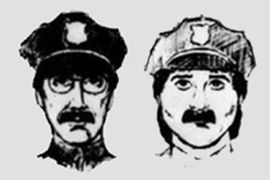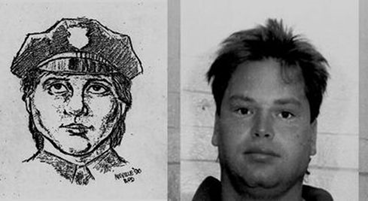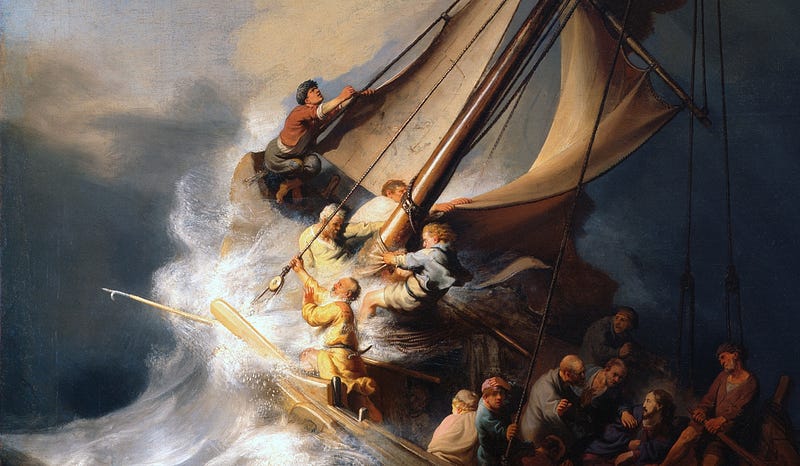18th March 1990 — Boston, New England
In the early 90s, the renowned art museum the Isabella Stewart Gardner Museum was targeted in an audacious theft to rival anything Hollywood can conjure up. Two thieves managed to gain entry to the museum by posing as police officers and make off with a haul valued at $500 million including Rembrandt’s masterpiece The Storm on the Sea of Galilee.
To date, it is not only the most notorious art theft on record but it is also unsolved and has a staggering reward in the millions for information that will lead to recovering some of the greatest works of art in the last millennia (and in human history).
The thieves posing as police were inside the museum for a total of eighty-one minutes and yet nabbed some of the most famous works of art and ‘successfully’ carried out arguably the largest robbery in history. The thieves took works belonging to Rembrandt, Degas, Manet and Flinck — names synonymous with ‘art’ and ‘mastery’.
But was the robbery itself a masterpiece in criminal artistry?
The FBI believe that the robbery was part of a large criminal enterprise, and the obvious cohorts in connection are the Boston Mafia (famously depicted in many great movies such as The Departed and Black Mass) but as of yet, the Gardner Heist remains a mystery.
The Stolen Paintings
1. The Concert by Vermeer (*this alone is estimated at around $500 million today)
2. Christ in the Storm on the Sea of Galilee by Rembrandt
3. A Lady and Gentleman in Black by Rembrandt
4. Landscape with Obelisk by Flinck
5. Chez Tortoni by Manet
6. Portrait of The Artist as A Young Man by Rembrandt
7. La Sortie de Pesage (two charcoal drawings) by Degas
8. Cortege aux Environs de Florence by Degas
9. Three Mounted Jockeys by Degas
10. A Bronze Eagle Finial by an unknown, French
11. An Ancient Chinese Gu
The Robbery
On that March night in 1990, two men buzzed on the intercom of the Isabella Gardner Museum and claimed to be calling about a disturbance in the courtyard. Thirty minutes earlier, while security was doing the rounds, a fire alarm sounded in the conservation lab on the fourth floor. Ten minutes after the first alarm, another alarm rang out in the carriage house — alerting security to the possibility of a fire. Again — there was nothing there.
It was a busier than usual night at the Isabelle Gardner and security was confused enough to let the “policemen” into the museum.
One OOneof the “police” began to “arrest” the first security guard, claiming there to be an outstanding warrant against the unsuspecting museum security guard Rick Abath.
Once Abath’s hands were cuffed, one of the men made it clear that this was a robbery and stated:
“Don’t tell them anything and in about a year you will get a reward.”
The accent was thick Bostonian.

One of the stick-up men was described by witnesses as “Asian-looking” with narrow/slanted eyes and a more rotund, and round-faced than the other assailant. While the other man had glasses and sharp, pointy features. Sharp eyes, a sharp pointy nose, and glasses.
Both two men wore mock police get-ups and were armed while using handcuffs to tie up the guards. Nobody was harmed during the robbery and the job was executed with criminal professionalism that suggested organisation — there were grace and expedient efficiency during the heist.
EXCEPT for the damage caused to the frames (and presumably the paintings) which were ripped and torn from the walls. This led the police to speculate that despite the heist being art focused, they were not art aficionados.
As they were preparing to leave the thieves took the video cassettes that recorded their entrance into the museum. However, the thieves’ movements could still be assessed while inside the museum due to the movement data that was left on the hard drive.

During the robbery the guard Rick Abath was handcuffed to the electrical box for eight hours with duct tape over his eyes, he sang Bob Dylan’s “I Shall Be Released” to keep sane.
Abath has expressed continual torment and remorse since letting the police into the Gardner museum
***
The most valuable works were taken from the museum’s Dutch Room. This included The Concert by Vermeer and The Storm on the Sea of Galilee by Rembrandt. Estimates have placed value on the Rembrandt at as much as $500,000,000. But given the history and skill of the piece, it is as priceless as the Mona Lisa.
The museum was not insured for the paintings and could not claim an indemnity. They were operating at low costs for both security, insurance, and maintenance. It seemed that for years the Gardner had operated under the shadow of complacency and criminals were fully aware of this, with discussions about robbing the Gardner going all the way back to the 1960s.
The FBI had previously uncovered a plot by Boston criminals to rob the museum in 1982 and despite improving security in the aftermath of this plot, the Gardner was using casual ex-police as security (often sleeping on duty) and were not insuring their priceless artworks. An early investigation by police into the security guards being involved in an inside job was quickly dismissed when the FBI deduced that the guards working the night in question were too incompetent and too foolish to have pulled off the heist.
Currently, the museum is offering ten million dollars for any information leading to the recovery of all 13 works and a separate reward of $100,000 for the recovery of the Napoleonic eagle finale The final itself was taken at great lengths, with the thieves ignoring a nearby Michelangelo to capture the final It was said to be a sought-after memento by the thieves and the reasons behind this could shed light on the case and motives.
The museum has left the empty frames hanging in the museum as a placeholder for the missing works and symbols of hope for their return. However, should the pieces be found in a Boston basement or sitting in somebody’s cellar, then the restoration required will be a gigantic task — a soggy damp cellar being the most catastrophic place to store such sensitive artwork.
The Suspects
WHITEY BULGER & THE IRA
The most famous Boston ganglord in history is Whitey Bulger. Depicted in both The Departed (a fictionalised version) and Black Mass (with Johnny Depp playing Bulger), Bulger was once the second most wanted man on the FBI Wanted List after Bin Laden and nearly all organised crime in Boston at that time had links to Whitey. Bulger was also a double agent working with the FBI and reporting on Italian American crimes.
A possible motive for the heist, speculated by the FBI, linked the Boston Mafia to the Irish Republican Army and determined that the theft could have had political motivations. There was a criminal devotion that the IRA had to Vermeer’s artwork including swiping paintings by the Dutch genius on three other separate occasions. The IRA were said to have had agents in Boston around that time and the strong links between Irish-Americans in Boston and the political organisation of the IRA led to rampant speculation that the heist was pulled off by Irish Republicans. The heist could have been motivated out of a need for military funding by the Irish Republicans with Whitey pulling the strings in America.
Bulger’s reign eventually came to an end, when federal prosecutors built up RICO charges against the mobster and after being tipped off, Whitey went into hiding from 1994 until 2011 — enticing a nationwide manhunt for nearly two decades.
Bulger was later beaten to death in prison in 2018.
DAVID TURNER & GEORGE REISSFELDER


Turner was an underworld associate of the infamous Merlino Gang. Turner had a list of previous offences which included cocaine trafficking and tried to bargain with police for a reduced sentence by having knowledge of the whereabouts of the artwork.

He also had features like that of the “Asian” features identified by witnesses, as well as being somewhat overweight and matching the descriptions given.
Reissfelder was convicted of a crime in 1967 and after serving 16 years was released for a wrongful conviction (this was for a murder he didn’t commit) in which the police admitted that they knew that Reissfelder was innocent while pressing charges. Reissfelder left prison a desperate man and slid back into the underworld.
The two men had their paths meet in the late ’80s when they both were drawn into Merlino’s cocaine business. The theory goes that the two men stole the artwork as insurance, should they be convicted of cocaine trafficking, they had a get-out-of-jail card in arranging a plea deal for the return of the paintings and artwork.
A year after the heist Reissfelder was found dead in his apartment from an alleged drug overdose, however, the details surrounding the death were shrouded in suspicion.
Turner was released in 2019 after serving 21 years in prison for a separate offence and is now living in Boston, where he refutes any involvement in the Gardner heist. Something of a media circus followed Turner’s release from prison, as he was a core suspect in the heist.
BOBBY DONATI
Much circumstantial evidence surrounds Donati, another local Boston hoodlum. However, there is little concrete to directly link Donati.
Donati was savagely murdered in 1991 not long after the robbery, when he was clubbed over the head and stabbed 28 times, later found in the trunk of a Cadillac in Revere, Massachusetts. Donati’s murder remains unsolved.
Donati’s trademark was using police uniforms in robberies he’d taken part in, much like the ones used in the Gardner heist and the FBI was said to have kept Donati under constant surveillance before his death.
Unfortunately, Donati’s home was not searched after his death and any opportunities to find the artwork there have been lost. It was said that Donati had long cased museums for many years with the desire of pulling off the ultimate heist. Donati was by trade, a professional stick-up artist.
STASHED IN DUBLIN?
In 2020 a tip-off was given that the items were in West Dublin, stashed behind the wall of a simple residential house. The tip-off was received anonymously by [allegedly] one of the most notorious gangsters in Ireland. How the artwork could get through customs, airport or shipping controls is yet another mystery in this case of course and the specific Irish address has yet to be identified but this doesn’t stop journalists and investigators from flocking to Ireland to try to find the lost Rembrandt amongst the others.
Hope remains that Gardner’s pieces will one day reappear. The Gardners remain hopeful with their empty frames shining from their walls as a beacon of both loss and hope. The police remain hopeful, with many of that criminal underworld now dying, ageing, and retiring — perhaps the stolen artefacts will one day be unearthed from a box or casket beneath that old Monopoly and Risk set, covered in a fog of dust.

There will one day be found, the priceless and enigmatic and beautiful art that shines eternal be it uncovered in Dublin, London, Boston or even discovered back in the Netherlands where Rembrandt once waved his magic brush.










Comments
Post a Comment